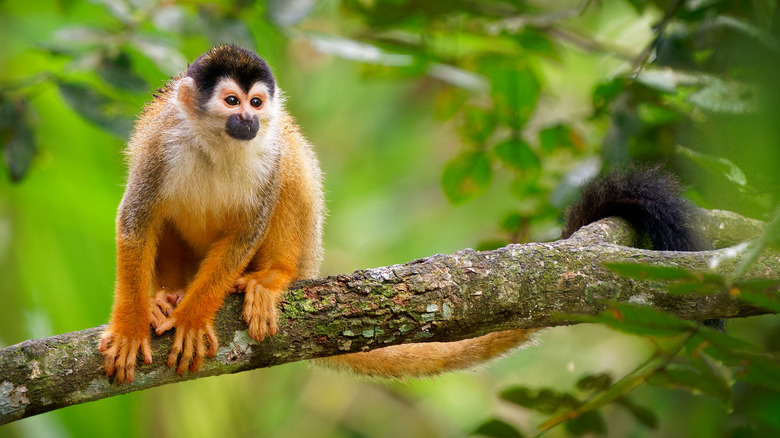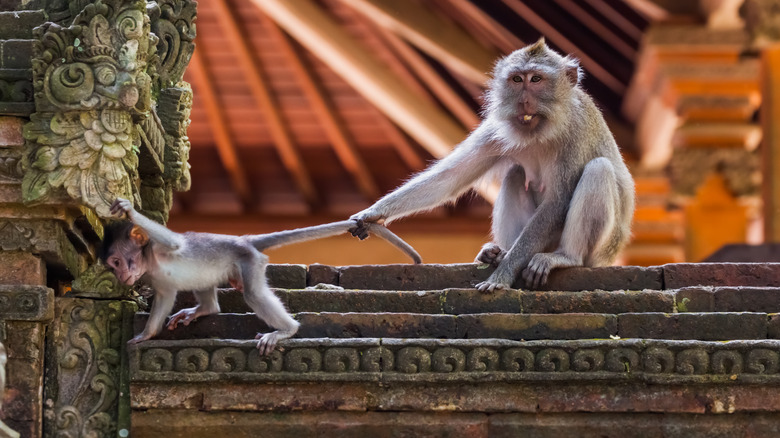What Would Happen If Humans Had Tails?
Tails are fascinating parts of the anatomy of numerous creatures around the world. In some cases, they're absolutely adorable, such as the puffy little tail of the poodle. They're not just for show, though. They're multifunctional.
According to the Blue Cross, a dog's tail is a surprisingly sophisticated barometer for the animal's feelings. A frenzied wag, naturally, often means that the dog attached to said tail is excited, while a tail between the legs (as the old saying goes) can indicate fear and apprehension. Per the outlet, dogs tend to start wagging their tails at around a month old.
Tails have many more functions, too. Spider monkeys, according to Andrés Link of Proyecto Primates (via National Geographic on YouTube), can manipulate their tails so deftly that they use them to traverse the treetops. In effect, Link said, "they have an additional limb." Meanwhile, here we humans are, without terrifically talented tails. If we did still have them (and we used to), it would change a lot more of our bodies than just the pants region.
The interesting tale of the tails we used to have
Curiously, humanity did have tails at one stage. Per Smithsonian Magazine, the hairier primates from which we evolved could travel in much the same fashion as today's spider monkeys. Those powerful tails suited an arboreal lifestyle perfectly. It seemed, though, that our ancestors lost their tails long, long ago, with species appearing sans tails around 25 million years ago.
In September 2021, the study "The genetic basis of tail-loss evolution in humans and apes," from Bo Xia et al (via preprint server bioRxiv) suggested that "The loss of the tail is one of the main anatomical evolutionary changes to have occurred along the lineage leading to humans." Per the study, it seems that a genetic quirk among our ancestors (perhaps even a single member of them) led to this difference, and so we are still tail-free today.
Well, almost tail-free. Healthline reports that human embryos have vestigial tails, which develop around a month-and-a-half into their development. About two weeks later, in most cases, they are absorbed and will form the coccyx. It's a fascinating link to our distant past, but why do some scientists consider it an advantage that our ancestors lost their tails? If they hadn't, our biology would be very different, and our internal organs would seemingly be a good deal less secure.
Human tails would be a mixed blessing
Dr. David Young of the University of Melbourne, via Pursuit, states that humans and their general bipedal gait are very well adapted to plodding along at ground level. "Gibbons can also walk bipedally along branches using their arms for balance," Young states. "A tailless upright posture is also well suited to climbing tree trunks." Of course, tree climbing is a favorite pursuit among some humans too, but the balance afforded by a tail would, by and large, be more appreciated by quadrupedal movers.
If we had tails, Science Alert reports, our bodies may look much the same as those of animals with tails: more vertebrae in the spine and additional muscles in the area to be able to control the tail. A new functional limb would require significant brain capacity to be able to control, too, and so this would potentially affect our minds. The outlet goes on to suggest that shorter, sturdier spines and muscles that protect our organs (which would otherwise have to be allocated to tail control) would be lost.
In "The Evolution of the Pelvic Floor of Primates" (via Online Library), Herbert Elftman suggests that it is "the presence of an adequate support of bone, muscle and fascia" that our erect gait requires to avoid serious injury in the region of the hips. If we had tails, it seems we wouldn't have (or necessarily need) this, but it would be an enormous biological change.


